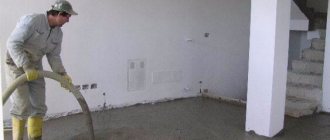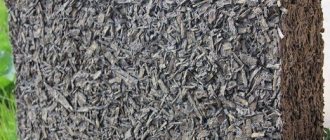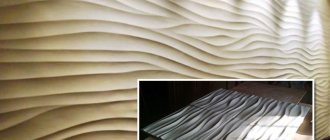Beton-House.com
Website about concrete: construction, characteristics, design. We combine the experience of professionals and private craftsmen in one place
Ready-made foam blocks
Foam concrete is used for the construction of enclosing structures of low-rise buildings and as insulation in structures together with other materials that play a load-bearing role (the strength of foam concrete products is relatively low). It is usually produced in the form of blocks, but construction from monolithic foam concrete is also developing.
In our article we will talk about the composition of the material and the selection of components, we will give the ratios of the components - and we will describe not only the mixture for foam concrete, but also the foaming agent. We will also briefly cover the technology, since the formulation of mixtures depends on it.
Knitting
The binding component is lime, Portland cement is the main substance used by builders for the construction of any object. Complies with GOST 10178-85.
Return to contents
Cement
Portland cement hardens under the influence of water and air. It is a composition of limestone and clay, which were initially fired. After sintering the mixture is enriched with calcium silicate. The quality of clinker - granules of the mixture, affects the strength, stability, and durability of the structure. Gypsum is added to it, which allows you to control the setting period of standard cement.
Portland cement is divided into 3 types:
- D0 – no additives;
- D5 – mixtures have less than five percent active mineral additives;
- D20 - the amount of additives varies from five to twenty percent, including 10% additives - minerals of hydraulic origin.
The grade of cement used for foam concrete has a density of 500 kg/m3, 400 kg/m3 with zero impurities. Sometimes they use a grade of 400 - 500, the additives of which are more than 5%.
Return to contents
Lime
Sometimes the main binding component is lime. The use of lime depends on the manufacturing technology of cellular concrete. Basic requirements for the substance: uniform firing, total activity above 75%, magnesium content less than one and a half percent. The total activity of lime is determined by the amount of active oxides of calcium and magnesium.
Lime can be used in the form of ground lime or fluff. Double-bottomed gypsum is added to the batch, which slows down the rate of lime slaking. Semi-aqueous gypsum with potash is also used.
Return to contents
Description of the components of the foam block
Now about each component in more detail.
Cement
If we focus on GOST (GOST 25485-89 Cellular concrete), then the binding element of a foam concrete block can only be Portland cement (PC) with a calcium silicate content of about 80%. However, if special strength is not needed, it is quite possible to replace it with slag Portland cement (SPC). In terms of volume, you will get some good savings.
When there is a desire to color the foam block during the production process, then, for a more accurate color match, it is better to choose white cement (BC).
What you should absolutely pay attention to is the production date of the cement. As a rule, its shelf life is six months. Don't buy for future use! The use of expired cement can lead to the fact that the finished foam block will have a strength lower than the calculated one!
Sand
According to GOST, sand must be at least 75% quartz. Foreign impurities such as clay and silt, for example, no more than 3%.
In practice, ordinary sifted construction sand is used.
Ideally, it is still better to wash it and filter it to a grain size of no more than 1.5 mm. Larger fractions will destroy foam bubbles during the production process.
Water
GOST “says” that water can only be used that has been tested for compliance with the salt composition.
In fact, the water is ordinary, purified to technical condition. Impurities are undesirable. Rigidity is as minimal as possible. During production, when certain foaming agents are used, the water is heated.
Air
This refers to air bubbles formed during the production process. Obviously, the fewer of them and the smaller they themselves are, the heavier the foam concrete block and the higher its density.
Foaming agents
They are divided into natural and synthetic.
Natural foaming agents, which are basically protein based, have been known for a long time. Made from natural ingredients, environmentally friendly and safe.
Synthetic foaming agents have appeared relatively recently. But they are used more and more often. Their consumption is much less, they form a more stable foam, and they practically do not come into contact with foam concrete additives. And, as a result, they significantly reduce the cost of the finished foam block. True, not all synthetics are environmentally friendly. Be careful!
Overall, the role of the foaming agent is extremely important. It is critically important that the wet foam concrete mass does not settle and does not release moisture. As a result, the density and strength of the future product directly depend on the durability of the foam and its load-bearing capacity during the production of a foam concrete block.
Supplements
The main ones are worth listing.
- Ash. Used frequently. Especially if a thermal power plant operates next to the production site. Ash is a waste after the production of solid fuel. Economically beneficial. In addition, the ash particles are small, which makes it possible to obtain denser foam concrete blocks. The downside of increased density is a decrease in energy-saving characteristics. To prevent strength from being affected, no more than 30% of the total mass of the filler is used.
- Fiber fiber. Increases the strength of the finished product by 15-25%. The result is a reinforced foam concrete block that can withstand increased loads.
- Calcium chloride. Accelerates the hardening of the foam block.
- Limestone. Partially replaces cement, no more than 30%. Increases frost resistance and strength.
- Microsilica. Increases the resistance of the foam concrete block to high temperatures and high acidity of the environment.
- Water repellents. Even their slight addition to the foam concrete mixture increases the strength of the finished foam blocks. Water resistance and frost resistance are also improved.
Knowing now what a foam concrete block consists of, you can try to make it yourself.
Fillers
Sand, ash, and other substances (tripoli, dragomite, etc.) are used as fillers. Foam concrete grade 500 is made excluding fillers. The use of finely ground fillers is possible. Foam blocks denser than 600 kg/m3 are made using sand.
Return to contents
Sand
The finer the sand, the better the quality of the foam concrete.
Must comply with GOST 8736: quartz in the composition must exceed seventy-five percent, domes - less than three percent. The grains of sand should be as small as possible. Their size affects the quality of foam concrete - less durable, uneven foam block made from coarse sand. They use sand from rivers and ravines - it is washed.
Return to contents
Ash
It can partially or completely replace sand in foam concrete, saving about thirty percent of cement. In many regions, fly ash is used - waste from thermal power plants. Thermal-humidity treatment will increase the strength of ash-based foam blocks.
Return to contents
Mixture recipe
One of the recipe brochures
When making foam concrete, the consumption of materials is selected depending on the required characteristics of the material. It is customary to divide foam concrete into grades that differ in strength and thermal conductivity. For foam concrete, the grade does not indicate compressive strength, but density and is designated by the letter D.
For information, foam concrete D800 and above is considered a structural material, grade below 400 is exclusively insulating. Intermediate grades are considered structural and thermal insulating.
Here are some sample characteristics of the brands:
| Brand | Thermal conductivity | Strength, MPa |
| D200 | not standardized | 0,005 |
| D300 | not standardized | 0,008 |
| D350 | 7,5-7,8 | 0,009 |
| D400 | 8,9-9,1 | 0,01 |
| D500 | 12,5-13,5 | 0,012 |
| D600 | 15-17 | 0,014 |
| D700 | 23-25 | 0,018 |
| D800 | 26-28 | 0,021 |
| D900 | 33-37 | 0,024 |
| D1000 | 48-52 | 0,029 |
| D1100 | 62-66 | 0,034 |
| D1200 | 87-93 | 0,038 |
Tip: When choosing a brand of foam concrete for your home, keep in mind that the wall bears not only its own weight, but also the load from the roof and ceilings - unless a special frame is provided for this.
In industrial enterprises, the composition of the mixture is selected after testing all the components of foam concrete in the laboratory, carrying out calculations. It was possible to give a calculation method, but it requires knowledge of concrete technology.
Therefore, it is easier to use ready-made recipes; a small difference in characteristics is unimportant in almost all cases. Therefore, we give the approximate composition of foam concrete and proportions.
Recipe for foam concrete for cement M500 and protein foaming agent:
| Foam concrete brand | D400 | D600 | D800 | D1000 | D1200 |
| Sand, tons | — | 0,21 | 0,42 | 0,59 | 0,78 |
| Cement M500, tons | 0,3 | 0,31 | 0,32 | 0,35 | 0,36 |
| Water for mixing the mixture, l | 115 | 115 | 125 | 125 | 145 |
| Water for diluting foam concentrate, l | 60 | 55 | 45 | 41 | 34 |
| Foaming agent, g | 1500 | 1300 | 1200 | 1000 | 910 |
| Pore volume in finished foam concrete, % | 75-85 | 65-75 | 60-70 | 50-60 | 40-50 |
| Foam concrete output, tons | 0,47 | 0,68 | 0,9 | 1,1 | 1,3 |
This is an approximate proportion of the foam concrete mixture, but if other materials are used, then adjustments are required. Also, if a plasticizer is introduced, then in accordance with its instructions it is necessary to reduce the proportion of cement and water for preparing the solution.
Other
Finely ground limestone is added in a proportion of 20 to 30 percent by weight of cement. It acts as a filler on a microscopic level to reduce internal tension during curing. This admixture gives the foam concrete composition additional frost resistance and reduces its cost.
Microsilica is used to impart strength to foam concrete. It is extracted during the smelting process of ferrosilicon in an electric furnace in the form of condensate from spherical microparticles of dust.
Polypropylene fiber protects foam concrete from plastic changes at the first stage of hardening of the mixture, preventing the appearance of microscopic cracks. The length of the fiber used for foam concrete is 0.6 - 2 cm. Foam blocks with fiber are durable, frost-resistant, and have clear, strong edges.
Return to contents
Materials and tools for laying walls
To lay foam blocks on the solution you will need:
roll-type waterproofing material (for example, roofing felt or membrane);- comb spatula;
- building level;
- beacons and mooring line;
- rubber mallet;
- Master OK;
- hacksaw for foam concrete with pobedit tips;
- flexible reinforcement in the form of rods.
Foaming agent
To create porosity of the material, a foaming agent is added, the composition of which includes: bone and flesh glue, rosin, caustic soda, scrubber paste. The composition of the solution requires a small proportion of foaming agent.
The foaming agent is divided into:
- artificial;
- natural – protein;
- adhesive flint.
The quality of German and Italian manufacturers of natural foam formers has been proven. The cost of such additives will be higher. As a result, foam concrete will equalize the cost with lower costs for Portland cement.
Return to contents
When additional insulation is needed
Structural foam blocks are no longer used for thermal insulation purposes. They have greater thermal conductivity and lower vapor permeability. Therefore, buildings constructed from foam blocks of grades d1000-d1200, with high heat transfer, require additional insulation. If we talk about the strength of this material, it is very high. These are the types of foam concrete that are used in multi-story construction. Structurally, porous blocks are not mass-produced, therefore they do not have the characteristics regulated by GOST. The high density of this material allows it to be used to construct buildings that are not limited in number of floors.
Accelerators
Accelerators are needed to increase drying abilities in the initial stages of hardening, especially when it is necessary to build a strong frame. Boosters:
- electrolytes – increase the dilution ability of cement;
- nitrate, calcium nitrite, potash - increase density;
- calcium hydrosulfoaluminate increases crystallization;
- Calcium chloride allows it to harden quickly, has a low cost, and a low dose is sufficient for the desired effect.
Acceleration must meet the requirement:
- it should not be too fast in order to lay out the solution efficiently;
- low cost of additives;
- ease of use.
The addition of silicate glass to the solution should be 2.4% of the amount of cement. Having such a dosage, it makes the mixture denser. With a larger dose, it causes rapid setting at the time of mixing and reduces the strength of foam concrete.
Return to contents
Summarize
As you can see, with the same amount of foaming agent, an increase in the mass of Portland cement and sand leads to an increase in the density of foam concrete. The higher the final density of foam concrete is expected, the higher the grain size of the sand used should be.
Although not everyone who uses foam concrete blocks in the construction of buildings makes them themselves. Still, understanding the proportions will help you understand its strength and other characteristics when purchasing a material.
Plasticizers
The introduction of such additives allows the mixture to become more plastic and flexible. They allow you to reduce the temperature of the technical impact on the structure, help the solution to better withstand frost, while reducing the ability to retain heat.
Requirements for plasticizers:
- compatibility with all ingredients;
- low level of volatility;
- lack of any aroma;
- chemically inactive substances;
- should not dissolve the polymers in the composition.
Return to contents
Specifications
We figured out what a foam block is. Now let's look at its performance. The main characteristics of the foam block are:
- Density is a quantity represented by the ratio of the weight of a material to its volume. It is designated by the letter “D” with numbers from 400 to 1,200. The strength of the foam block depends on this indicator;
- the weight of the foam block - its dependence is determined by the density at a normal level of humidity. Weight can vary between 8.5 – 47 kg. Having clarified this indicator, it becomes possible to determine the mass of one cubic meter of material;
- resistance to low temperatures - measured by the number of “freezing-thawing” cycles, has different values. Blocks with the highest rating are used in the construction of facilities beyond the Arctic Circle;
- foam block parameters are determined by GOST. For an external wall - 20 x 40 cm, for an internal type load-bearing wall - 30 x 20, for a partition - 10 x 30. Moreover, the length of the foam blocks of each group is the same and is 60 cm.
Proportions for obtaining 1 m3 of foam concrete
Brands D400
It has low strength properties and is used as insulation. Has proportions:
- Portland cement – 300 kg;
- sand 120 kg;
- foam formers – 850 g;
- water 155 l.
Return to contents
Brands from D600 to D1000
They create a good structure, retain heat, and are suitable for building houses. Has proportions:
- Portland cement - 325 kg;
- sand – 205 kg;
- foaming agent – 1.05 kg;
- water – 182 l.
Return to contents
Brands D800
Proportions:
- Portland cement – 390 kg;
- sand – 335 kg;
- foaming agent – 1 kg;
- water – 225 l.
Return to contents
Preparation of the solution
Before starting work on preparing the masonry mixture for foam blocks, you should make sure that you have all the necessary tools. You will need:
- The mixing container is a large trough or basin; if you have it, it’s better to take a concrete mixer;
- Bucket;
- Construction mixer or drill;
- Shovel.
The finished glue must be used within 40 minutes; it is applied to the surface in a thin layer using a notched trowel.
Steps for mixing a ready-made adhesive solution purchased in a store:
- Pour the dry mixture into a dry, clean container and dilute it with water, in the ratio of 1 kg of powder per 200 ml of water. A bag in standard packaging weighing 25 kg will require approximately 5 liters of water;
- Stir the mixture thoroughly until smooth using a mixer or drill with a special attachment;
- Leave the resulting mass to rest for 10 minutes, during which time the mixture will gain the required consistency;
- Stir the solution again and you can use it.
The preparation of cement mortar is not much different from ready-made mixtures. Cement and sand are placed in a large container; the main proportions of the mortar for laying foam blocks are 1 part cement and 4 parts sand. Mix the dry ingredients thoroughly.
Before pouring water into the mixture, additives - plasticizers and foaming agents - are diluted in it. You don’t have to use them, but then the solution will lose a number of properties - moisture resistance, resistance to temperature changes and strength.
Mix the mixture well until smooth, it is important to ensure that no lumps form. The solution can be used within several hours.











